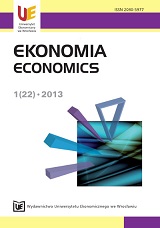Funkcje sektora bankowego w gospodarce: przypadek Indii
Economic functions of the banking sector:the case of India
Author(s): Adam MarszkSubject(s): Economy
Published by: Wydawnictwo Uniwersytetu Ekonomicznego we Wrocławiu
Keywords: India; banking sector; commercial banking; banking sector functions
Summary/Abstract: The purpose of this article is to examine the impact of one of the most important elements of the economic system, i.e. banking sector, on the real economy in India and to determine how and to what extent it affects economic development. The analysis was conducted using information on the Indian banking sector from different sources (mainly from the Indian Central Bank). Large part of the analysis was based on the interpretation of the selected statistical data. In the first part of the text, the theoretical concepts concerning the relationships between the activities of banks and real economy are discussed. The four primary functions of banks are: increasing the efficiency of resource allocation (through risk assessment of investment projects), mobilization of savings (enabling clients to deposit money leads to increased savings rate), limiting liquidity and credit risks and reducing transaction costs (in real and financial segments of economy; in financial system it is associated with banks using economies of scale). In the next part of the article, the history and current situation of the sector in India are presented. Due to a strict state control policy, imposed in India for a few decades, the role of private and foreign banks is insignificant and the sector is dominated by state (public) banks whose efficiency is lower. Despite the liberalization of the banking sector which has been carried out since the beginning of the 1990s, the extent of state control is still wide and its primary element is directed lending limits including providing loans to certain priority sectors such as agriculture, small and medium-sized enterprises, retail trade and in the form of mortgage loans. The limits are high and are currently set at 40% for domestic banks and 32% for foreign banks. Such requirements pose a significant problem for banks because this type of credit portfolio is of low quality and a large proportion is eventually classified as non-performing loans. The banking sector as a whole is poorly developed compared to richer countries, both in terms of size (measured as a value of deposits and loans in relation to GDP) and availability and quality of offered services (low activity of banks in the populous rural or semi-rural areas, low number of ATMs and payment cards). Another symptom of banking sector backwardness is the low level of credits in relation to deposits, not only much lower than in highly developed countries, but also than in other countries of the BRIC group (to which India belongs). Indian banks provide loans mainly to companies in the industrial (45% of the total value) and services sector (about 24%). Given the key India development barriers, a positive aspect is the high proportion (14%) of loans granted to companies in infrastructure sector, mainly involved in energy production and distribution – power failures are one of India’s major economic and social issues.
Journal: Ekonomia
- Issue Year: 2013
- Issue No: 22
- Page Range: 110-126
- Page Count: 17
- Language: Polish

